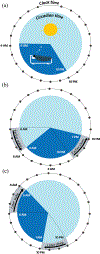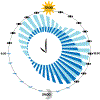The Negative Effects of Travel on Student Athletes Through Sleep and Circadian Disruption
- PMID: 37978840
- PMCID: PMC11262807
- DOI: 10.1177/07487304231207330
The Negative Effects of Travel on Student Athletes Through Sleep and Circadian Disruption
Abstract
Collegiate athletes must satisfy the academic obligations common to all undergraduates, but they have the additional structural and social stressors of extensive practice time, competition schedules, and frequent travel away from their home campus. Clearly such stressors can have negative impacts on both their academic and athletic performances as well as on their health. These concerns are made more acute by recent proposals and decisions to reorganize major collegiate athletic conferences. These rearrangements will require more multi-day travel that interferes with the academic work and personal schedules of athletes. Of particular concern is additional east-west travel that results in circadian rhythm disruptions commonly called jet lag that contribute to the loss of amount as well as quality of sleep. Circadian misalignment and sleep deprivation and/or sleep disturbances have profound effects on physical and mental health and performance. We, as concerned scientists and physicians with relevant expertise, developed this white paper to raise awareness of these challenges to the wellbeing of our student-athletes and their co-travelers. We also offer practical steps to mitigate the negative consequences of collegiate travel schedules. We discuss the importance of bedtime protocols, the availability of early afternoon naps, and adherence to scheduled lighting exposure protocols before, during, and after travel, with support from wearables and apps. We call upon departments of athletics to engage with sleep and circadian experts to advise and help design tailored implementation of these mitigating practices that could contribute to the current and long-term health and wellbeing of their students and their staff members.
Keywords: academic and athletic performance; chronic jet lag; circadian misalignment; sleep and circadian health; student mental health.
Conflict of interest statement
Conflict of interest statementThe authors have no potential conflicts of interest with respect to the research, authorship, and/or publication of this article.
Figures



Similar articles
-
Circadian disruption and remedial interventions: effects and interventions for jet lag for athletic peak performance.Sports Med. 2012 Mar 1;42(3):185-208. doi: 10.2165/11596850-000000000-00000. Sports Med. 2012. PMID: 22299812 Review.
-
Reentrainment of the circadian pacemaker during jet lag: East-west asymmetry and the effects of north-south travel.J Theor Biol. 2018 Jan 21;437:261-285. doi: 10.1016/j.jtbi.2017.10.002. Epub 2017 Oct 4. J Theor Biol. 2018. PMID: 28987464
-
Hormonal and pharmacological manipulation of the circadian clock: recent developments and future strategies.Sleep. 2000 May 1;23 Suppl 3:S77-85. Sleep. 2000. PMID: 10809190 Review.
-
Managing Travel Fatigue and Jet Lag in Athletes: A Review and Consensus Statement.Sports Med. 2021 Oct;51(10):2029-2050. doi: 10.1007/s40279-021-01502-0. Epub 2021 Jul 14. Sports Med. 2021. PMID: 34263388 Free PMC article. Review.
-
Altered sleep-wake cycles and physical performance in athletes.Physiol Behav. 2007 Feb 28;90(2-3):274-84. doi: 10.1016/j.physbeh.2006.09.017. Epub 2006 Oct 25. Physiol Behav. 2007. PMID: 17067642 Review.
Cited by
-
How did I come to sleep research and stay there?Sleep Adv. 2024 Nov 1;5(1):zpae074. doi: 10.1093/sleepadvances/zpae074. eCollection 2024. Sleep Adv. 2024. PMID: 39494051 Free PMC article. No abstract available.
-
Impact of Early Season Jump Loads on Neuromuscular Performance in Division I Volleyball: Analyzing Force, Velocity, and Power From Countermovement Jump Tests.Transl Sports Med. 2025 Apr 4;2025:7216781. doi: 10.1155/tsm2/7216781. eCollection 2025. Transl Sports Med. 2025. PMID: 40225832 Free PMC article.
References
-
- Aschoff J, Hoffmann K, Pohl H, and Wever R (1975) Re-entrainment of circadian rhythms after phase-shifts of the zeitgeber. Chronobiologia 2(1):23–78. - PubMed
-
- Bonnar D, Bartel K, Kakoschke N, and Lang C (2018) Sleep interventions designed to improve athletic performance and recovery: a systematic review of current approaches. Sports Med 48:683–703. - PubMed
-
- Borbély AA, Daan S, Wirz-Justice A, and Deboer T (2016) The two-process model of sleep regulation: a reappraisal. J Sleep Res 25:131–143. - PubMed
Publication types
MeSH terms
Grants and funding
LinkOut - more resources
Full Text Sources
Miscellaneous

